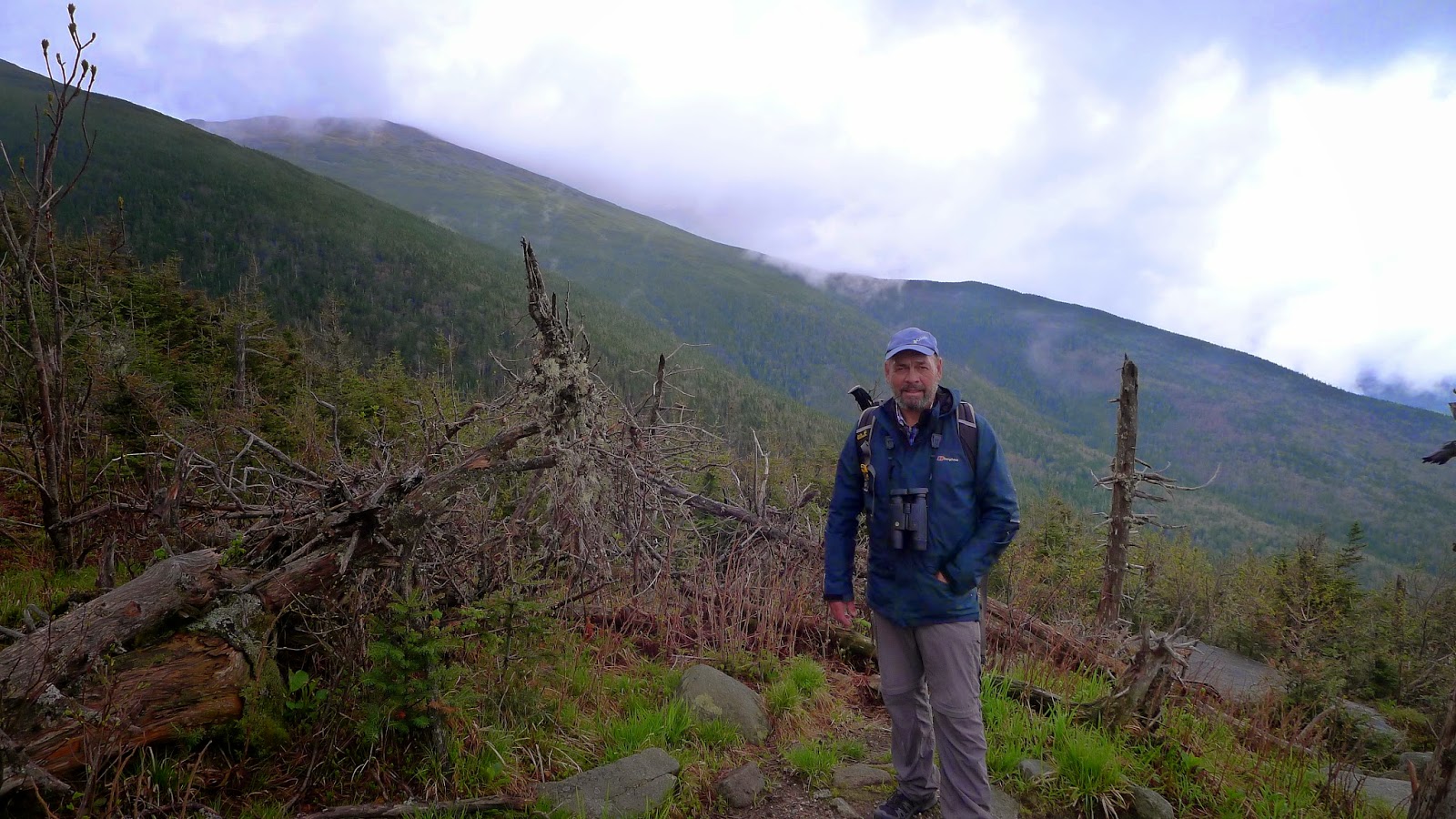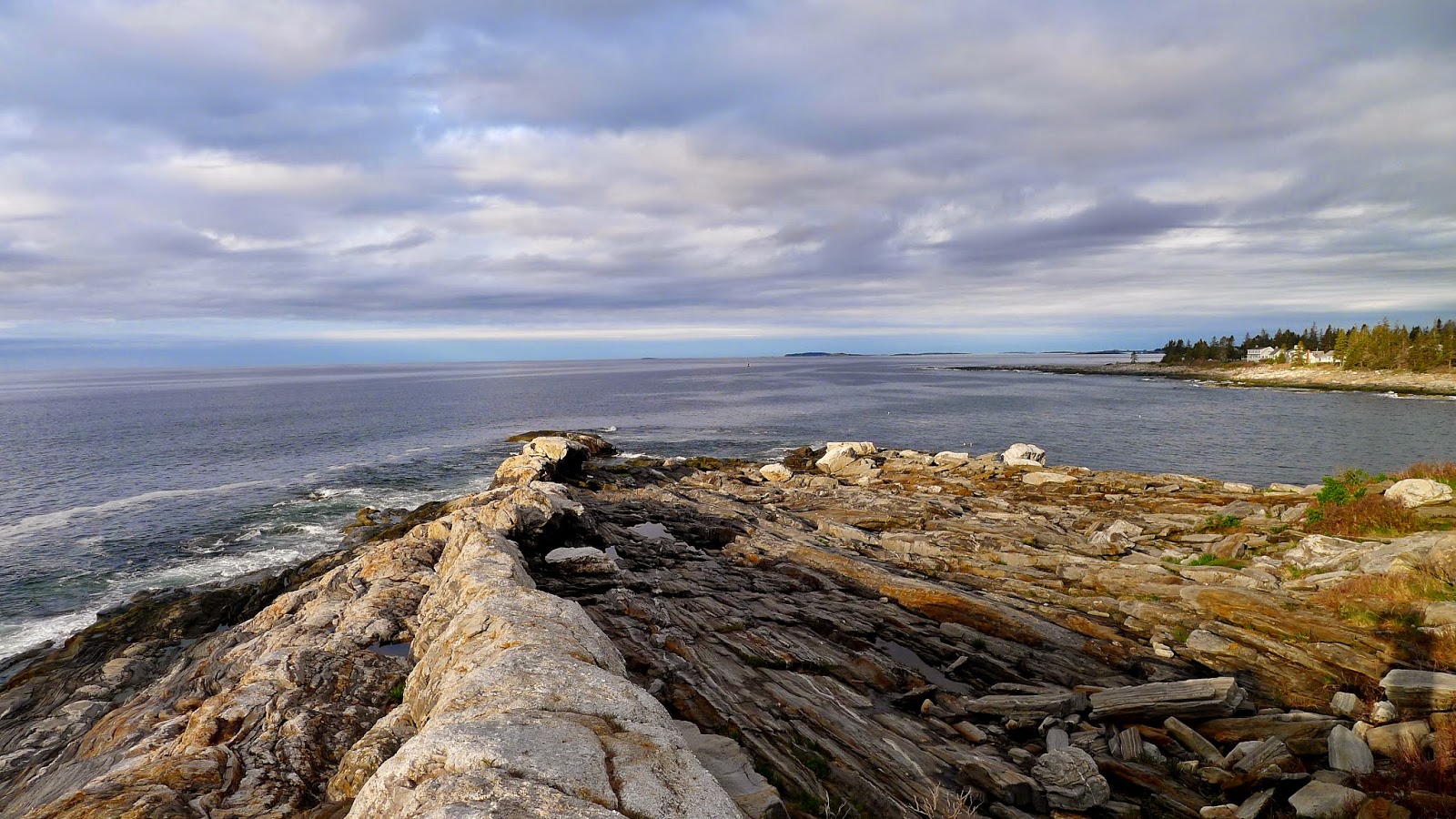It is Saturday 31st May & we slept in! A mad scramble & we are off, burning up the tarmac, heading north into New Hampshire. Our destination was the beautiful White Mountains, but my secret (or maybe not so secret) agenda, was Bicknell's Thrush, which is endemic to this area.
The monstrosity in the foreground is the
Mount Washington Resort.
The Caps Ridge Trail may be seen behind
the left hand turret of the building.
We decide to explore the newly opened Jefferson Notch Road & to hike up the Caps Ridge Trail. The trail is well marked but quite narrow, birding is difficult. I had made the decision earlier to leave my big lens in the car, as the trail was steep & one mis-placed foot & an expensive lens is no more! The weather was low cloud & a little drizzle at first, so photography inside the forest would have been very difficult anyway. We made good progress & I was leading and saw a Bicknell's Thrush briefly perched on a horizontal log just above the ground. It was a brief sighting, but enough to confirm the identification & I was very pleased with myself!
On the way up, the weather was very mixed.
The correct elevation & habitat for my main quarry!
Here we are at 3,700 feet above sea level.
The Caps Ridge Trail above the lookout,
to the summit.
Looking back down the valley,
the way we had walked.
Me, on the lookout rock.
We climbed as far as a lookout rock, which would have given magnificent view of both mountain & valley if only the low cloud hadn't been present. Barbara decided to climb higher, while I stalked the stunted forest looking for more Bicknell's Thrushes! Barbara discovered the higher rocky section was very wet & slippery & with two other climbers turned around. One slip & you could be in trouble.
It's in here! Honest!
It's in the bag! Bicknell's Thrush, at last!
I was haunting the forest & the conditions were getting slowly better i.e. I could see further than 20 metres! We descended very slowly. I had worked out the contact call of Bicknell's Thrush & I stopped as I heard a pair calling to each other, but I couldn't see them. Barbara's sharp eyes saw one perched on a log & I enjoyed quite prolonged views of this much anticipated species. Thanks Barbara! The Bicknell's Thrush finder extraordinaire! I knew there was a reason I let you follow me around! I was absolutely elated by this sighting & by the end of our hike, we had recorded six Bicknell's Thrush, three of which, were sightings.
The Bicknell's Thrush finder!
Best birds: Winter Wren; 5+ Golden-crowned Kinglet; 6 Bicknell's Thrush; 2 Magnolia Warbler; 3 Black-throated Green Warbler; 4 Yellow-rumped Warbler; 6 Blackpoll Warbler; Canada Warbler & 8 Dark-eyed Junco.
The view from a much lower elevation
of Barbara's father's veranda.
Apparently, both Beyoncé & Marvin Hagler
have summer homes on that ridge!
We then checked into our accommodation for the night, (which turned out to be excellent) & visited Barbara's father in Bartlett.
Live music in the bar.
This is what people around here
get up to in the winter!
A bit chilly for me!
After this we frequented a nice Irish pub in nearby Jackson & whiled away the evening listening to local live music, eating & drinking. It was a lovely evening but we got to bed much later than anticipated & this had its consequences the next morning, as we once again slept in!
1st June & breakfast in the garden of the Motel. A beautiful morning, but we couldn't linger too long, as we had set ourselves an ambitious hike for the rest of the day.
The beautiful river, at the start of the trail.
At one with nature!
Some great fungi were seen on the trail.
A little further along the trail.
We were to hike the Nancy Pond Trail. The trail head is just off the 302 road & at first it is a pleasant walk through deciduous woodland. But it gets progressively more difficult as one ascends. Six river crossings take time & a bit of care! And the switchbacks from the cascade (waterfall) to the top are quite strenuous as well as being a little scary for those who do not have a head for heights! ie me!
Nancy Pond.
It is 1st June & still there are small patches
of snow around.
Cheeky!
Once you are on the plateau, you reach Nancy Pond very quickly & it is in a lovely setting. After lingering here some time, we slowly walked on to Norcross Pond, which is even more scenic & at the head of the pond, is a fantastic view into the wilderness area. Well worth the hike up there.
The wonderfully scenic, Norcross Pond.
Barbara, at Norcross Pond.
Looking into the P
At this point we turned around & slowly made our way down back to the car. Birding was difficult in the enclosed forest & with the trail being quite hard, not suitable for carrying my large lens up there. I also missed all of my target species: Spruce Grouse; Grey Jay; Black-backed Woodpecker & Rusty Blackbird. We heard Grey Jay & the woodpecker but just couldn't get a glimpse in the thick forest. However, I did get two further sightings of Bicknell's Thrush. A lovely day in fantastic surroundings.
Our adventures were not quite over, as we pulled into Twin Mountain for a quick meal before our long drive home. The quick meal turned into a bit of a vigil, as all the staff were drunk! They had been celebrating the owner of the restaurant daughters graduation. Barbara did all of the driving (& found the best sighting of Bicknell's Thrush)! It was after 1.30am before we tumbled into bed & oblivion! It had been a good weekend though.



























































































































